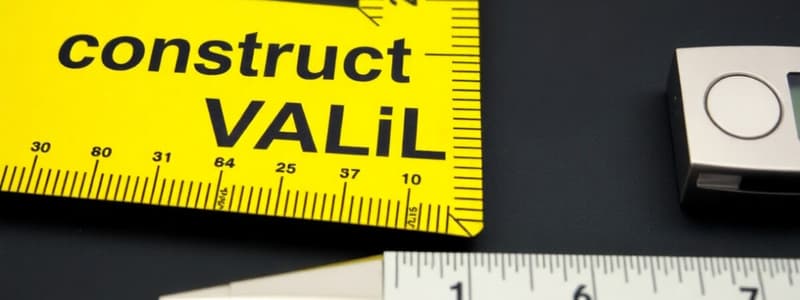Podcast
Questions and Answers
What does concurrent validity primarily assess?
What does concurrent validity primarily assess?
- The consistency of scores with another known criterion (correct)
- The future predictive ability of a measure
- The range of topics covered by a measure
- The relationship between different constructs
Which example best illustrates predictive validity?
Which example best illustrates predictive validity?
- Two measures assessing the same construct show a strong relationship
- Administering a depression scale and another measure concurrently
- Using a risk assessment to forecast future behavior of offenders (correct)
- Matching questionnaire content to an established definition
Which of the following defines content validity?
Which of the following defines content validity?
- Assessing the correlation between a test and a future event
- Demonstrating high scores across multiple tests of the same construct
- Evaluating the relationship between two different constructs
- Comparing measure content with the established construct definition (correct)
What does convergent validity indicate?
What does convergent validity indicate?
What does the validity of a measurement procedure indicate?
What does the validity of a measurement procedure indicate?
In assessing divergent validity, what would be expected?
In assessing divergent validity, what would be expected?
Which scenario illustrates a lack of validity in measurement?
Which scenario illustrates a lack of validity in measurement?
Which option exemplifies content validity in an intelligence measure?
Which option exemplifies content validity in an intelligence measure?
What is face validity?
What is face validity?
What is a key characteristic of concurrent validity?
What is a key characteristic of concurrent validity?
Why is face validity considered a minimum requirement?
Why is face validity considered a minimum requirement?
Which scenario best illustrates the concept of divergent validity?
Which scenario best illustrates the concept of divergent validity?
In which case might a measure lack validity according to cultural context?
In which case might a measure lack validity according to cultural context?
Which of the following is NOT a type of validity?
Which of the following is NOT a type of validity?
How can elevated heart rate be misinterpreted when measuring attraction?
How can elevated heart rate be misinterpreted when measuring attraction?
What is the relationship between reliability and validity?
What is the relationship between reliability and validity?
Flashcards
Concurrent Validity
Concurrent Validity
Concurrent validity refers to how well a new measure of a construct compares with an already established and accepted measure of the same construct, when measured at the same time.
Predictive Validity
Predictive Validity
Predictive validity refers to how well a measure can predict future outcomes or events.
Content Validity
Content Validity
Content validity refers to how well the content of a measure accurately reflects the concept it is intended to measure.
Convergent Validity
Convergent Validity
Signup and view all the flashcards
Divergent Validity
Divergent Validity
Signup and view all the flashcards
Validity in research
Validity in research
Signup and view all the flashcards
Face Validity
Face Validity
Signup and view all the flashcards
Reliability in research
Reliability in research
Signup and view all the flashcards
Test-Retest Reliability
Test-Retest Reliability
Signup and view all the flashcards
Internal Consistency Reliability
Internal Consistency Reliability
Signup and view all the flashcards
Inter-Rater Reliability
Inter-Rater Reliability
Signup and view all the flashcards
Reliability vs. Validity
Reliability vs. Validity
Signup and view all the flashcards
Key takeaway: Validity and Reliability
Key takeaway: Validity and Reliability
Signup and view all the flashcards
Study Notes
Validity in Measurement
- Validity assesses if a measurement procedure accurately measures the intended variable.
- It's crucial for indirectly observed variables, where the relationship between a measure and the concept being measured might be complex.
- Validity isn't inherent to a measure; it's evaluated based on different types.
Types of Validity
-
Face validity: A measure appears to measure the intended construct. This is a basic requirement but can be subjective.
- Example: Items on the DASS-21 ("I found it hard to wind down") have high face validity for measuring stress.
-
Concurrent validity: A measure compares well with a known criterion (another established measure) at the same time.
- Example: A new depression measure is compared with a well-established scale like the HDRS. Consistency suggests both measures are valid.
-
Predictive validity: A measure accurately predicts future events.
- Example: A pretrial risk assessment predicts future criminal behavior by evaluating court attendance and new offences.
-
Content validity: A measure comprehensively covers the construct's components.
- Example: To measure intelligence, a measure should assess various aspects like reasoning and problem-solving, as outlined in Gottfredson's definition.
-
Convergent validity: Strong relationship between two measures of the same construct.
- Example: The BDI-II and RADS both measure adolescent depression, showing a strong overlap in their scores.
-
Divergent validity (discriminant validity): Little or no relationship between measures of different constructs.
- Example: Low correlation between depression and social anxiety scores, supporting that they are distinct constructs.
Studying That Suits You
Use AI to generate personalized quizzes and flashcards to suit your learning preferences.



